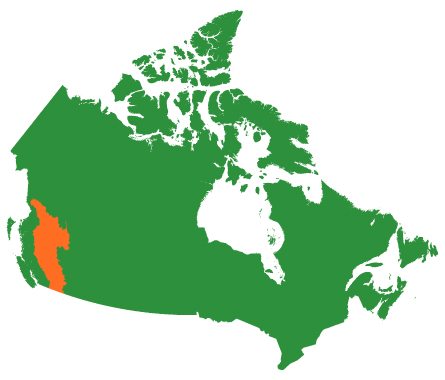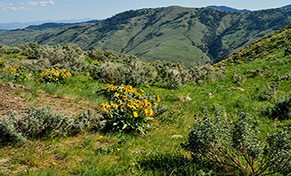BC INTERIOR
Federal ecozones: Semi-arid Plateaux, Montane Cordillera
Area: 290,388 km2
Natural cover: 286,156 km2
Per cent natural: 99%
Protected area: 43,005 km2
Per cent protected: 15%
Number of NCC projects (all): 44
Number of species of birds: 278
Number of species of trees: 59
Number of species of mammals: 94
Number of species of amphibians: 16
Estimated human population: 891,178

Description
From the sun-drenched valleys of the Okanagan Similkameen to the vibrant grasslands of the Thompson Nicola and open forests of the Fraser Plateau, the interior of British Columbia hosts an array of beautiful and ecologically distinct landscapes. Clear lakes, wetlands and rivers give way to gently rolling hills and rising open forests.
Situated in the rain shadows of the high coastal mountain ranges, this region has some of the driest and hottest places in Canada, and a high numbers of species at risk. This region is dominated by montane forests characterized by a patchwork of grasslands and open Douglas-fir and ponderosa pine woodlands.
BC Interior Landscape

Conservation Values
This region has a very high diversity of habitats, ranging from grasslands, to open forests, to valley land wetlands, to arid, desert-like landscapes. It is particularly rich in rare species, and includes many plants and animals that are not found in other locations in Canada. The region provides habitat for grizzly bear, lynx, fisher, badger, black bear, elk, bighorn sheep, mule deer and wolverine. The valley lands have a high diversity and abundance of waterfowl and other breeding birds, including Barrow’s goldeneye, yellow-headed blackbird, greater yellowlegs, long-billed curlew and ring-billed gull.
This landscape shelters the heartland of the BC river system, with the Fraser and Thompson rivers running through it. The Fraser is still a wild river with few dams.
Challenges/Threats
The BC Interior faces a number of growing threats, including resource extraction, new dams, expanding land conversion, invasive species and declining water quality and quantity. Due to fire suppression, the region’s grasslands are threatened by the encroachment of forests into the area. Meanwhile, more than 80 per cent of mature trees in the region have been killed by mountain pine beetle and subsequently logged, changing the region’s hydrology.
The Okanagan is the most threatened portion of the BC Interior due to expanding residential, agricultural and recreational development and the spread of invasive plants. Its valley bottom has experienced a significant (almost 90 per cent) loss of wetlands, although the rate has slowed. The region is also a hot spot for agricultural production of grapes and tender fruit.
Grasslands in this region are declining, and only small remnants now occur. More than 90 per cent of the grasslands are grazed by cattle, which can result in grasslands that are maintained at early successional stages.
What NCC is doing
NCC has identified priority conservation sites in a number of natural areas, including:
- Heritage Grasslands
- South Okanagan Similkameen
NCC is protecting habitat for many species at risk in the region, including:
- burrowing owl
- American badger
- Lewis’s woodpecker
- Lyall’s mariposa lily
NCC’s Sage and Sparrow Conservation Area shares a significant portion of its border with the South Okanagan Grasslands Protected Area, forming an integral habitat link between protected areas that allows for the movement of species between the Similkameen and Okanagan Valleys.

Did you know?
- This area supports one of the largest numbers of nationally at-risk plant species in Canada.
- It contains most of the remaining grasslands, shrub-steppe and low-elevation dry forests in BC.
- It is a critically important movement and connectivity corridor that connects the larger Columbia Basin in Washington and the grassland habitats of the Thompson Nicola Valley.
- The region supports 75 per cent of all bird species known to occur in BC and the greatest diversity of breeding bird species in BC.
- It includes the northern extent of Canada’s only desert-like habitat.
- It includes significant spawning habitat for sockeye and Chinook salmon.
- Large wetlands in the valley lands are important breeding waterfowl areas.
Photo Credits (Top to bottom): All images by Kristian Bogner.

